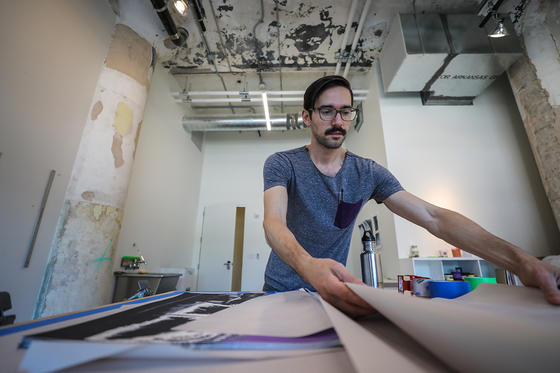Christopher Kardambikis never set out to create work that would sit behind glass or live in private collections. Instead, he found his voice and purpose through publishing zines, artist books, and prints—things people could hold, trade, collect, and care about without needing a trust fund.
Now an associate professor and director of studio art at George Mason University's School of Art, Kardambikis brings that same ethos into the classroom. He teaches printmaking, book arts, and a deeply collaborative publishing minor that opens students up to something much more tangible than the "starving artist" cliché.
"I want the work to be distributed," he says. "I want normal people to actually access it."
It's a perspective shaped not just by art school or gallery walls but by real-world experiences that most students never hear about. Before coming to George Mason, Kardambikis worked as an artist's assistant and then at an art shipping warehouse in Long Island, New York. His job? Packaging up expensive artwork and preparing it for storage, sometimes indefinitely.
"There's so much work that just sits in crates," he recalls. "These paintings get bought by wealthy collectors, but no one ever sees them. They're not even being enjoyed. They're investments, sitting on shelves."
With print-based art, he found a medium that could move freely, outside the confines of exclusivity.

His long-running podcast Paper Cuts was born from that same spirit of access. Launched initially during his artist residency at Pioneer Works in Brooklyn, the project started as a way to interview zinesters and small press artists as an excuse to talk to people about the books they make. Over the years, it's grown into a traveling platform for community, collaboration, and archival storytelling.
It also gave him a way to connect. "When I moved to new cities—Pittsburgh, San Diego, LA, New York—I always started a publishing project. That's how I made friends. That's how I met people and became part of a scene."
At George Mason, he's helping students see how print and publishing can do the same for them.
Students team up with working artists, presses, and organizations across the region through the School of Art's Dynamic Publishing minor. They produce real books, collaborate with local creatives, and watch their work move from concept to finished product—all while developing a skill set that's adaptable, entrepreneurial, and community-focused.
And while he's quick to point out that not everyone needs to start their own press, he wants students to understand the range of what's possible. He introduces them to people building careers through small studios, cooperative print shops, local arts education, and community-centered creative work.
"You're not limited to being in a gallery," he says. "You don't have to wait for someone to give you permission."
One of his goals is to help students see just how resourceful they already are. In his classes, students don't just learn the techniques. They learn how to plan, produce, and problem solve, often using materials or processes far outside traditional expectations. "You learn to do the research, figure it out, and follow your vision wherever it leads. That's not something you can teach in theory. You have to live it."
He also believes deeply in the relevance of physical work in a digital-first world. Books, he says, still matter. Maybe now more than ever.
"Websites disappear. Apps go away. But books can last hundreds of years. They're solid. They hold stories. They're touchable, tangible, real."
It's not about resisting technology. It's about remembering that the physical and the digital don't have to be at odds. In fact, for many of his students, learning how ink interacts with paper changes how they think about design altogether.
"Once they've made something by hand. Once they've printed it, folded it, held it, it shifts how they understand what they're doing," he says. "It gives it weight."
And for Kardambikis, that's the point: helping students create work that carries weight not just on the page but also in the world.
Related Stories
- November 17, 2025
- November 3, 2025
- October 30, 2025
- October 16, 2025
- October 6, 2025
